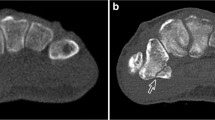Abstract
Introduction
Magnetic resonance imaging (MRI) is the radiological modality of choice for diagnosing pathological fractures in situations of diagnostic uncertainty. With the increasing availability of MRI, we have observed a disturbing trend in utilising routine MRI scans to exclude pathological fractures in all patients with a history of cancer. The study objective was to determine if routine use of MRI scans in such patients is truly necessary and if other predictive factors can be utilised in lieu of the MRI scan.
Materials and methods
A 3-year retrospective study was conducted reviewing all extremity MRI scans performed for suspected pathological fractures and compared to X-rays. All patients presented with an extremity fracture, a known diagnosis of solid organ cancer and had an MRI to determine if the fracture was pathological. Subjects were followed up with serial X-rays up to 1 year.
Results
84 subjects were recruited. Comparing X-rays alone with MRI scans revealed 92% sensitivity and 98% specificity in detecting pathological fractures. Using X-rays in combination with an absent history of trauma increases the sensitivity to 100% but reduced the specificity to 91%. None of subjects in cancer remission had pathological fractures.
Conclusions
MRI is an imperative tool for operative planning in pathological fractures; however, we recommend against the routine use of MRI to diagnose pathological fractures in oncological patients. Patients with solid organ cancer remission, a positive history of significant trauma prior to sustaining the fracture, and the absence of pathological features on plain radiographs are strongly predictive against pathological fractures.



Similar content being viewed by others
References
Heck RKJ (2013) Malignant tumors of bone. In: Canale ST, Beaty JH (eds) Campbell’s operative orthopaedics, 12th edn. Elsevier, Philadelphia
Hage WD, Aboulafia AJ, Aboulafia DM (2000) Incidence, location and diagnostic evaluation of metastatic bone disease. Orthop Clin N Am 31:515–528
Clain A (1965) Secondary malignant disease of bone. Br J Cancer 19:15–29
Tsuzuki S, Park SH, Eber MR et al (2016) Skeletal complications in cancer patients with bone metastases. Int J Urol 23:825–832
Rybak LD, Rosenthal DI (2001) Radiological imaging for the diagnosis of bone metastases. Q J Nucl Med 45:53–64
Kattapuram SV, Khurana JS, Scott JA et al (1990) Negative scintigraphy with positive magnetic resonance imaging in bone metastasis. Skelet Radiol 19:113–116
Fayad LM, Kawamoto S, Ihab R et al (2005) Distinction of long bone stress fractures from pathologic fractures on cross-sectional imaging: how successful are we? Am J Roentgenol 185:915–924
Fayad LM, Kamel IR, Kawamoto S et al (2005) Distinguishing stress fractures from pathological fracture: a multimodality approach. Skelet Radiol 34:245–259
Hu YC, Lun DX, Wang H (2012) Clinical features of neoplastic pathological fracture in long bones. Chin Med J (Engl) 125(17):3127–3132
Buckwalter JA, Brandser EA (1997) Stress and insufficiency fractures. Am Fam Physician 56:175–182
Toy PC, Heck RKJ (2013) General principles of tumors. In: Canale ST, Beaty JH (eds) Campbell’s operative orthopaedics, 12th edn. Elsevier, Philadelphia
Wedin R (2001) Surgical treatment for pathologic fracture. Acta Orthop Scand 72(4):1–29
Hanna SL, Fletcher BD, Fairclough DL, Jenkins JH 3rd, Le AH (1991) Magnetic resonance imaging of disseminated bone marrow disease in patients treated for malignancy. Skelet Radiol 20:79–84
Funding
There is no funding source.
Author information
Authors and Affiliations
Corresponding author
Ethics declarations
Conflict of interest
The authors declare that they have no conflict of interest.
Ethical approval
This article received ethical approval and is in accordance with the ethical standards of the institutional research board and with the 1964 Helsinki declaration and its later amendments or comparable ethical standards.
Rights and permissions
About this article
Cite this article
Seng, D.W.R., Kwek, E.B.K. Is routine MRI necessary to exclude pathological fractures in patients with an oncological history?. Arch Orthop Trauma Surg 138, 1633–1637 (2018). https://doi.org/10.1007/s00402-018-3012-z
Received:
Published:
Issue Date:
DOI: https://doi.org/10.1007/s00402-018-3012-z




